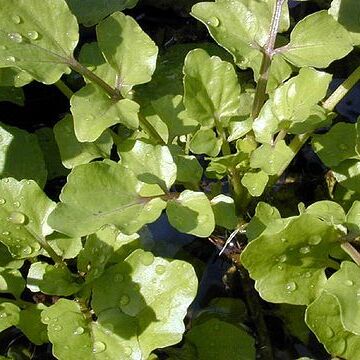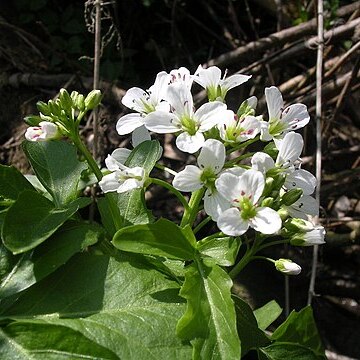Perennials; (aquatic, rhizomatous, rooting at proximal nodes); not scapose; often glabrous, sometimes pubescent. Stems prostrate or decumbent, or erect in emergent plants, unbranched. Leaves cauline; not rosulate; petiolate; petiole base sometimes auriculate, blade (pinnately compound in emerged plants, or simple in deeply submerged plants, lateral leaflets petiolulate or sessile, 1-6(-12) pairs), margins entire, repand, or, rarely, dentate. Racemes (corymbose, several-flowered), elongated in fruit. Fruiting pedicels divaricate or descending, slender, (glabrous or adaxially puberulent). Flowers: sepals erect or ascending, oblong [ovate], lateral pair subsaccate or not saccate basally, (glabrous); petals usually white, rarely pink, obovate or narrowly spatulate, (longer than sepals), claw undifferentiated from blade, (attenuate to clawlike base, apex obtuse, acute, or rounded); stamens tetradynamous; filaments (white), not dilated basally; anthers oblong, (apex obtuse); nectar glands (2), lateral, annular or semiannular. Fruits siliques, sessile, usually linear, rarely narrowly oblong, smooth or slightly torulose, straight or slightly curved, terete; valves each obscurely veined, glabrous; replum rounded; septum complete; ovules 25-50 per ovary; style obsolete or distinct; stigma capitate. Seeds plump, not winged, oblong or ovoid; seed coat (minutely to coarsely reticulate), not mucilaginous when wetted; cotyledons accumbent. x = 8.
More
Herbs perennial, aquatic, rhizomatous. Trichomes absent or simple. Stems prostrate or decumbent, erect in emergent plants, rooting at proximal nodes. Leaves all cauline, pinnately compound, often simple in deeply submersed plants; petiole sometimes auriculate at base; lateral leaflets 1-6(-12) pairs, petiolulate or sessile, entire, repand, or rarely dentate. Racemes many flowered, ebracteate. Fruiting pedicels usually divaricate. Sepals ovate or oblong, erect or ascending, glabrous, base of lateral pair subsaccate or not saccate. Petals white or rarely pink, longer than sepals; blade obovate or narrowly spatulate, apex obtuse; claw absent. Stamens 6, erect, tetradynamous; filaments base not dilated; anthers oblong, obtuse at apex. Median glands absent; lateral glands 2, annular or semiannular. Ovules 25-50 per ovary. Fruit dehiscent siliques, linear or rarely narrowly oblong, terete, sessile; valves obscurely veined, glabrous, smooth or slightly torulose; replum rounded; septum complete; style obsolete or to 2 mm; stigma capitate, entire. Seeds uniseriate or biseriate, wingless, oblong or ovoid, plump; seed coat minutely to coarsely reticulate, not mucilaginous when wetted; cotyledons accumbent.


